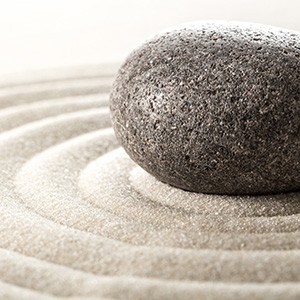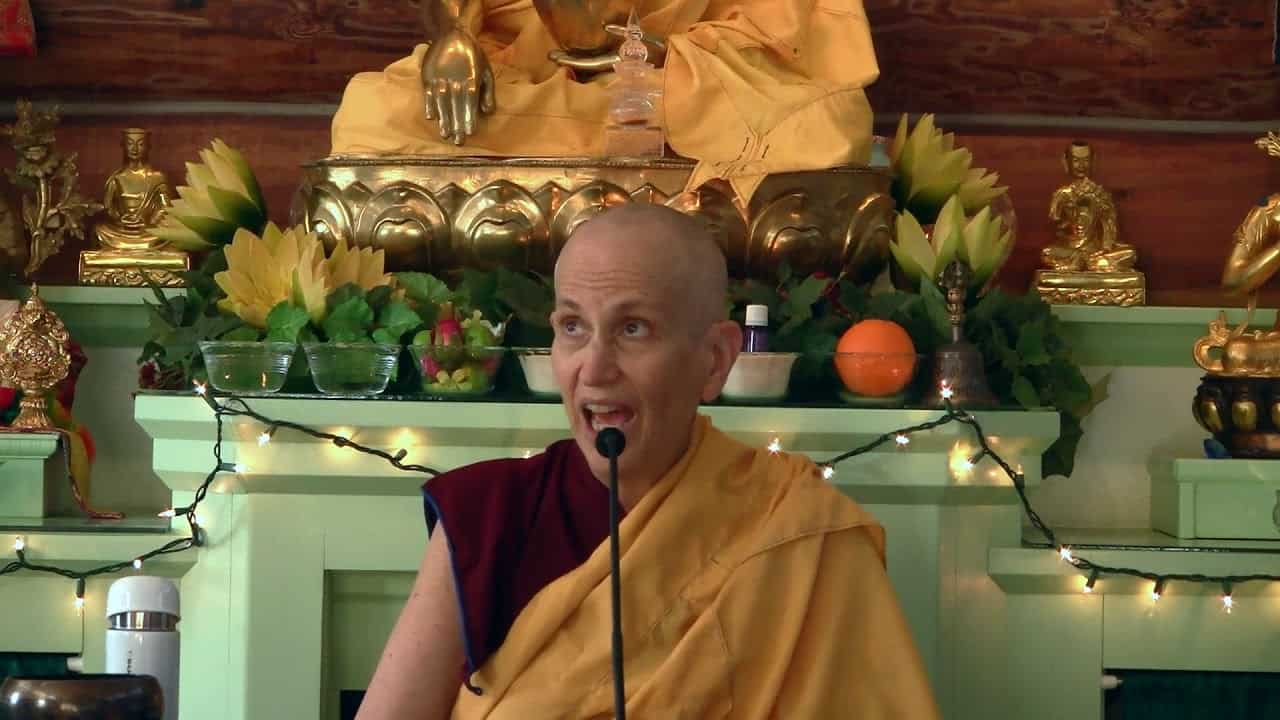Ensuring our connection with the teachings and teacher
Part of a series of short commentaries on the Amitabha sadhana given in preparation for the Amitabha Winter Retreat at Sravasti Abbey in 2017-2018.
- The last three limbs of the 7-limb practice
- The importance of requesting the spiritual mentor to teach
- Ensure our ongoing access to Dharma teachings from qualified spiritual mentors
To continue the discussion of the seven-limb prayer. We talked about prostrating, offering, confession, and rejoicing. The next two—requesting and entreating—sometimes they come in that order, sometimes they come in the reverse order. It doesn’t really matter.
Requesting
Requesting is requesting the Buddha and our teachers for teachings. And entreating is entreating them to live a long life. Both of these function on the side of creating merit by requesting teachings and asking our teachers to live a long life and asking the Buddha to continually manifest in our world and teach us. But they also, I think, help us purify destructive karma that we’ve created in relationship to the Three Jewels and to our spiritual mentors, such as taking them for granted, or taking being able to receive teachings for granted.
I’ve really seen this, especially in our country where we’re used to just… We should have everything. Everything should appear to us. Everything should be here. We’re the consumer that can pick and choose what we want to do and what we want to have. That’s kind of our attitude in wealthy countries. And it breeds a certain kind of complacency and really taking things for granted that can make us miss out on incredible opportunities.
For example, when I first started practicing I was living at Kopan Monastery in Nepal. There were teachings all the time. Then I lived in India, I went to the Library of Tibetan Works and Archives and went to classes daily. My teachers were around me, I could go and ask questions when I wanted to, and there were interactions with them, and so on. Then I got sent to Italy, to this new Dharma center that was beginning, and I was the only sangha member when I first arrived there. I had only been ordained two years, so I was really a “baby” nun. And there I was at this Dharma center. No teachers. No sangha. How was I going to get an education? And how was my practice going to be enriched?
This was back in the 1970s. No email. No YouTube videos of teachings. No anything like that. Just even having audio recordings did not always happen. So you really had to have the presence of your teachers there. And then all of a sudden when I was doing the seven-limb prayer this one about requesting teachings and requesting my teachers to live long became really important, because I was out in the middle of the desert, figuratively. Pomaia wasn’t a desert, but Dharma-wise it was.
So, all of a sudden these two of the seven limbs really came quite to the forefront and I began requesting very sincerely, because it really came to me that without being near my teacher, or senior sangha that I could learn from, I was going to turn into a dried up fig, Dharma-wise.
Also, at that time, Lama Yeshe was not always very well. He wound up dying a few years later. And then really thinking about my teacher’s mortality… They’re not always going to be there. And how much I took it for granted when I lived in Asia that these things were there all around me and I could enjoy them whenever I wanted to.
When I first started teaching in the West I noticed this kind of attitude very much with Western Dharma students as well. People would come semi-regularly to teachings, but then they said, “Oh, I have to drive half an hour across town to get to the Dharma center, and I’m just too tired to do that after work.” Or, “I wanted to come on this weekend retreat but I had to do the laundry, and I have these other things….” And it really struck me how, in our culture where we’re used to having access to everything, it all becomes very ordinary. So these people were missing out on teachings because driving half an hour was too long for them.
I went halfway around the world to get teachings because there were no Dharma centers in America when I started out. But to drive a half an hour across town was too difficult.
It’s so easy to have that kind of attitude of, “Well, the center’s always there, the monastery’s always there, the teacher’s always there, so I can go off and do other things, and have a good time, and have my samsara. Then when I have problems then I can go back and maybe hear some Dharma and do some meditation.”
That kind of attitude really makes us miss wonderful opportunities. So it’s something to be very careful about. And I think that’s why these two limbs are included in the seven-limb prayer. To request teachings. Because when we request we have to think of, “What do I want to learn?” The importance of learning. And we have to put some energy out. We don’t just kind of when we’re walking past our teacher say, “And by the way will you teach me….” You go and you bow three times, you bring an offering, you make a request. And traditionally the teacher says “no” the first two times. And then to show our sincerity we go back again and ask again. That’s how it’s traditionally done and that helps us really appreciate the teachings and take them seriously when we do hear them.
Entreating
Similarly, requesting our teacher to live long in the seven-limb prayer helps us appreciate the presence of our teachers in our lives.
And here, I must say, that whereas technology has been very good at spreading the Dharma very widely to places where there are no teachers, and it’s been wonderful that way, in another way I sometimes wonder if it makes some of the students who live close by a little bit lazy. Because, “Well, I don’t need to drive up to the Abbey, or I don’t need to go to the Dharma center, because anyway it takes too long, and I have to go there and sit on a cushion and sit up straight, and they have a schedule, and I’ve got to follow the schedule, and I can’t get up in the middle of the teachings, and I can’t stretch my legs towards the Buddha…. But if I listen to the teachings at home, then I can listen at my convenience, I can turn them off halfway if they’re not so interesting. I can lean back in my easy-chair and put my legs up. I can drink a little bit, have a little snack while I’m listening to Dharma teachings….” So I wonder sometimes if that happens for the people who live nearby who could very easily come up, but they don’t. And the thing is it’s always much better, if you have the opportunity, to hear the teaching live rather than through recording or online.
Of course, if you have no other options, online is fantastic. It’s really good. But if you have the option, and the ability to hear it directly, sitting in a teacher’s presence really makes a difference. I know it did for me. Tremendously. Because I was able to sit there and listen… Be in the presence of people who actually practiced this. And so much is conveyed when you’re in the presence of somebody that you don’t get on an audio recording. Especially when you’re navigating the interstate highway. So it’s good to do that when we can.
Anyway, these two limbs are quite important in our lives.
Dedication
Then the seventh is dedication. Dedication is actually a practice of generosity, a practice of making offerings, because we’re saying whatever merit we created through doing the previous six limbs, and whatever merit we created in other situations, and actually all the merit that all sentient beings have created from the tenth ground bodhisattvas down to whatever little bugs create, all this merit of the past, present, and future we’re dedicating for the awakening of all sentient beings. So it’s a time of really rejoicing in our own and others’ merit, sharing that merit, mentally dedicating it.
The dedication is really expressing our aspiration. We’re not dedicating it to winning the lottery. We’re not dedicating it so your son or daughter marries somebody nice. Or so that you get into a certain college, or whatever. We’re dedicating it for the alleviation of suffering of each and every living being. Especially for our own enlightenment, but of course the enlightenment of everybody else. And then we can also add other dedications there for people who are sick, for people who have recently died; people who have obstacles to remove their obstacles; people who need some energy for success, to dedicate for their success. But when we dedicate we always make sure we dedicate for the highest thing. And then the other things we add as like a postscript. Not quite a postscript, it’s not like we’ve forgotten, but they’re not as important. Sometimes what we do is first we dedicate for all the worldly things, and then maybe we remember to dedicate for enlightenment at the end. But we should do it the other way around and always dedicate for the highest awakening of ourselves and others, and then for all the other conditions, for the Dharma to exist and spread, and then for whoever is experiencing difficulties that we need to make dedications for.
[Explanation of the wording “turning the wheel of Dharma,” which refers to requesting teachings.]
We say that Shakyamuni Buddha was a “wheel turning” buddha in that he taught the Dharma in an age where the Dharma had not been taught before in this particular world system. So those are called the “wheel turning buddhas.” Then in another way, “turning the wheel of Dharma,” that expression can be used in a very loose way, meaning just giving teachings.
Venerable Thubten Chodron
Venerable Chodron emphasizes the practical application of Buddha’s teachings in our daily lives and is especially skilled at explaining them in ways easily understood and practiced by Westerners. She is well known for her warm, humorous, and lucid teachings. She was ordained as a Buddhist nun in 1977 by Kyabje Ling Rinpoche in Dharamsala, India, and in 1986 she received bhikshuni (full) ordination in Taiwan. Read her full bio.


